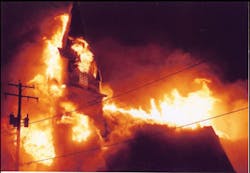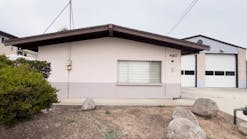On The Job – Wisconsin: Waukesha Firefighters Endure Extreme Cold at 3-Alarm Church Fire
WAUKESHA FIRE DEPARTMENT
Chief: Allen LaConte
Personnel: 94 career firefighters
Apparatus: Four engines, one aerial, one Special Services Team, two ALS med-engines, one ALS ambulance, two BLS ambulances, two reserve engines, one reserve platform, two reserve ambulances
Population: 89,000 day, 69,000 night
Area: 24.3 square miles
On Dec. 4, 2005, a three-alarm fire destroyed the 115-year-old Evangelical and Reformed United Church of Christ in downtown Waukesha, WI. Crews initially found the church entirely charged with heavy smoke, making it impossible to locate the seat of the fire until it broke through the eaves. Water supply was challenging at a fire of such magnitude, and extremely cold weather also hampered firefighters.
The 10,000-square-foot stone-and-brick church was built in 1891 with interior wood-frame construction similar to balloon type, but was not the typical balloon construction. The peaked roof had a wood deck covered with asphalt shingles. Originally, the roof was covered with shake shingles. It is not known whether the shake shingles were under the asphalt shingles. The church did not contain any fire alarm, detection or protection systems. A 12,000-square-foot, two-story addition built during the 1960s contained the church school. This building was made of brick with a steel frame and concrete interior with a flat asphalt roof. The school contained a manual alarm system that was not monitored and did not contain any automatic detection or suppression system.
The Waukesha Fire Department was dispatched to a report of a structure fire at the church located at 413 Wisconsin Ave. at 10:16 P.M. Engines 1561, 1562, 1563 and 1564, Ladder 1571 (a 75-foot aerial) and three ambulances responded with 23 firefighters under the command of Battalion Chief Joseph Vitale. The church was located a half-mile from Fire Station 1. As Vitale turned on to Wisconsin Avenue, smoke was visible in the area. Arriving in front of the church, heavier smoke seemed to be originating from the rear of the church, but no flames were visible. Vitale continued to do a 360 exterior size-up, ending up in the parking lot at the rear of the church (side C). He ordered Engine 1561 and Ladder 1571 to the rear parking lot and assigned the crews to investigate and extinguishment operations. Engines 1562 and 1564 and Ambulances 1552 and 1554 responded to side A. Engine 1563 laid 300 feet of supply line to the rear of the church to supply Engine 1561. Ladder 1571, assisted by Engine 1563, laid two 200-foot supply lines to the rear of the church. Engine 1563 hooked onto a hydrant and pumped to Ladder 1571. Firefighters on side A stretched 100 feet of three-inch line from Engine 1562 that was wyed into two 100-foot 1¾-inch attack lines into the front of the church.
Crews from Engines 1562 and 1564 forced entry into a side A entrance and were met by heavy smoke. The firefighters proceeded up a set of stairs toward the sanctuary, where they encountered extreme heat and fire. Firefighters at the rear advanced a 100-foot three-inch line reduced to a 100-foot 1¾-inch line into the rear of the building from Engine 1561. Forcing entry into a C-side entrance that led to the lower level, the crew initially encountered light smoke. After proceeding another 15 feet, heavier smoke and fire conditions were encountered. With heavy smoke pushing from the lower and upper shingle roof lines and steeple, Vitale transmitted a working fire signal at 10:20.
Vitale requested a second alarm at 10:23. Callback personnel from the Waukesha Fire Department responded with Ladder 1572, a 100-foot aerial platform. Interior crews attempted to extinguish the fire, but due to rapidly deteriorating conditions and heavy fire becoming visible at the roof line and in the basement windows, Vitale ordered firefighters to evacuate the building at 10:30. At this time, defensive operations were initiated using master streams. Engine 1561 supplied one portable deck gun and Ladder 1571’s master stream were placed into operation at the rear of the church. Engine 1562 supplied a portable master stream in front of the church and Engine 1564 operated its deck gun at the front.
Vitale requested a third alarm at 10:51. This brought mutual aid from Town of Brookfield, City of Brookfield, Pewaukee and Town of Waukesha. Town of Brookfield Ladder 2272 and manpower were requested to respond to the scene. An engine and ambulance from each of the other mutual aid departments were assigned to each of the three outlaying City of Waukesha fire stations to cover any additional calls. City of Waukesha Ladder 1572 laid a 700-foot supply line to the front of the church and operated its elevated master stream. The rear of the two residential structure exposures on Maple Street (side B) were protected by a portable master stream on the A-B corner, supplied by Engine 1564.
Multiple 1¾-inch handlines were operated by crews at the rear, supplied from Engine 1561, to protect the church school and the residential structures. Firefighters advanced one handline to the upper floor of the school to search for fire extension. Minimal fire extension occurred where the two buildings connected near an elevator. Ceilings were pulled in the upper-floor classrooms, but no fire extension was found.
Assistant Chiefs Steve Howard and Kevin Croegaert arrived on scene at 11:37. Howard assumed command of the A-B sector and Croegaert took charge of the C-D sector. Master streams and handlines controlled the fire and protected the church school and nearby homes.
Vitale declared the fire under control at 2:53 A.M. on Dec. 5. Mutual aid departments were released at 4 A.M. Vitale transferred command to Croegaert at 6:01 A.M. Waukesha crews remained on scene for the remainder of the week.
Forty Waukesha and 20 mutual aid firefighters used four engines and two aerial devices to fight the fire.
An investigation by the Waukesha Police and Fire Department Investigation Team, Wisconsin Department of Criminal Investigation and a national response team from the Bureau of Alcohol, Tobacco and Firearms (ATF) lasted a week. It was determined that candles were left lit on an Advent wreath in the sanctuary. Damage was estimated at $3.8 million to the structure and $400,000 to the contents. Two firefighters suffered minor injuries from falling on ice. The church school suffered moderate smoke and water damage.
Firefighters faced several challenges fighting this fire. The last church parishioners had left the church at 5 P.M. after attending a funeral. A Waukesha police officer on routine patrol noticed smoke coming from the church and contacted the dispatch center to learn whether there was a report of a church fire. Dispatch notified the fire department at this time. Crews initially found the church entirely charged with heavy smoke, making it impossible to locate the seat of the fire until it broke through the eaves. Getting sufficient water supply to fight the fire was a challenge, but with the assistance of the Water Department, the water pressure was increased as much as possible.
The extremely cold weather (7 degrees) also hampered firefighting efforts. Two City Metro buses were brought to the scene for rehab of the firefighters. Crews rotated frequently into the buses to get warm. Icy conditions made walking extremely difficult for the firefighters.
Even though there was no formal pre-plan of the building, firefighters were familiar with the layout of the building because of numerous EMS runs to the church. Firefighters had been trained on firefighter evacuation plans throughout the year and had just completed training on water supply and elevated master stream operations.
Standard operating procedures (SOPs) for firefighter evacuation and Mayday procedures are being updated. Radio communications worked well during the incident and played an important role as the incident commander knew the locations of the interior crews and was able to advise them to evacuate the building as conditions worsened. Fire companies are continuing to create and update pre-plans throughout the community.
Lessons Learned
Keep pre-plans updated.
Maintain proficiency in firefighter evacuation plans.
Pre-arrange water company response to large-scale incidents.
Jay K. Bradish/IFPA, Firehouse® news editor, is a former captain in the Bradford Township, PA, Fire Department. He has been a volunteer firefighter and fire photographer for more than 25 years.






